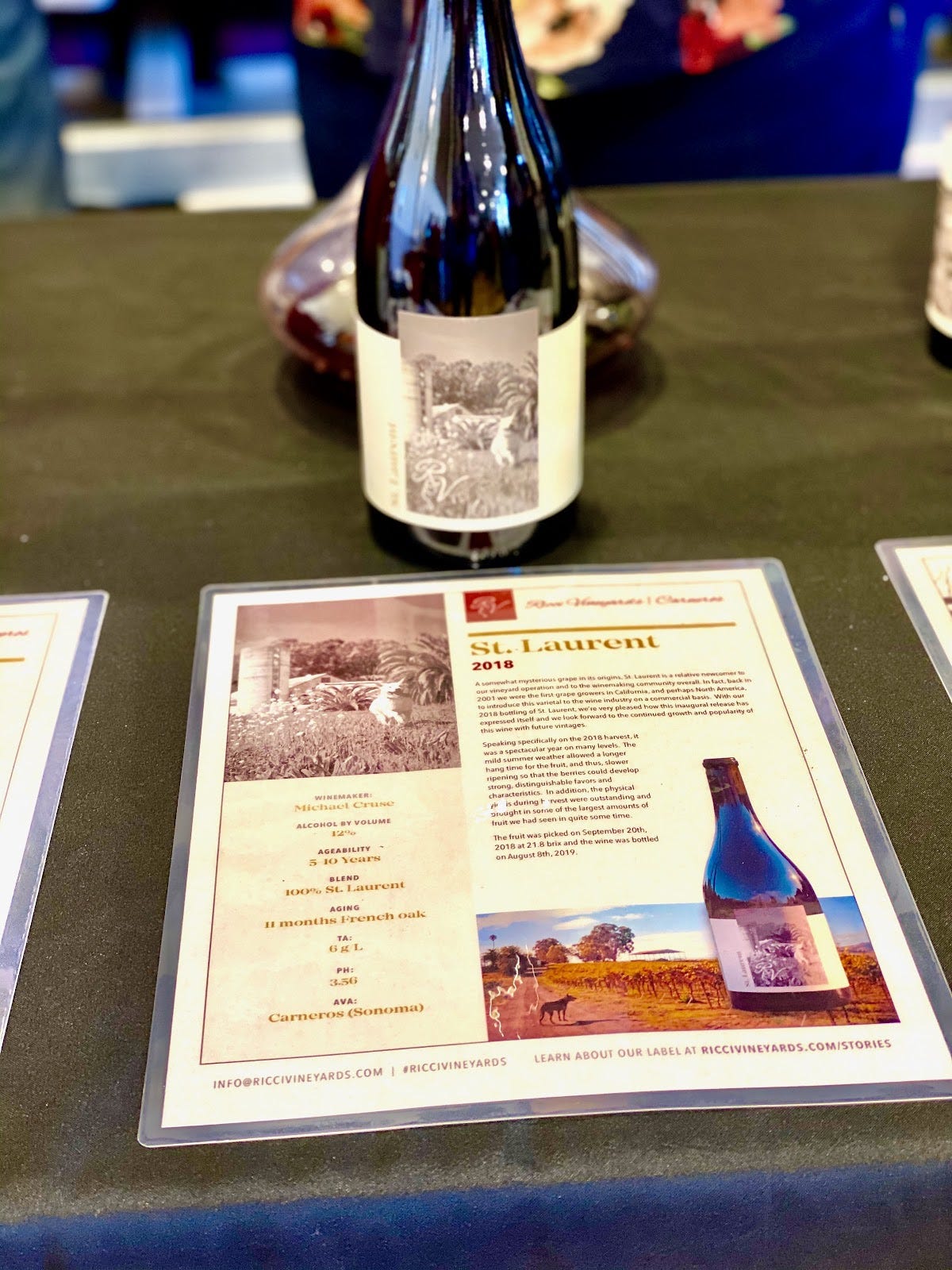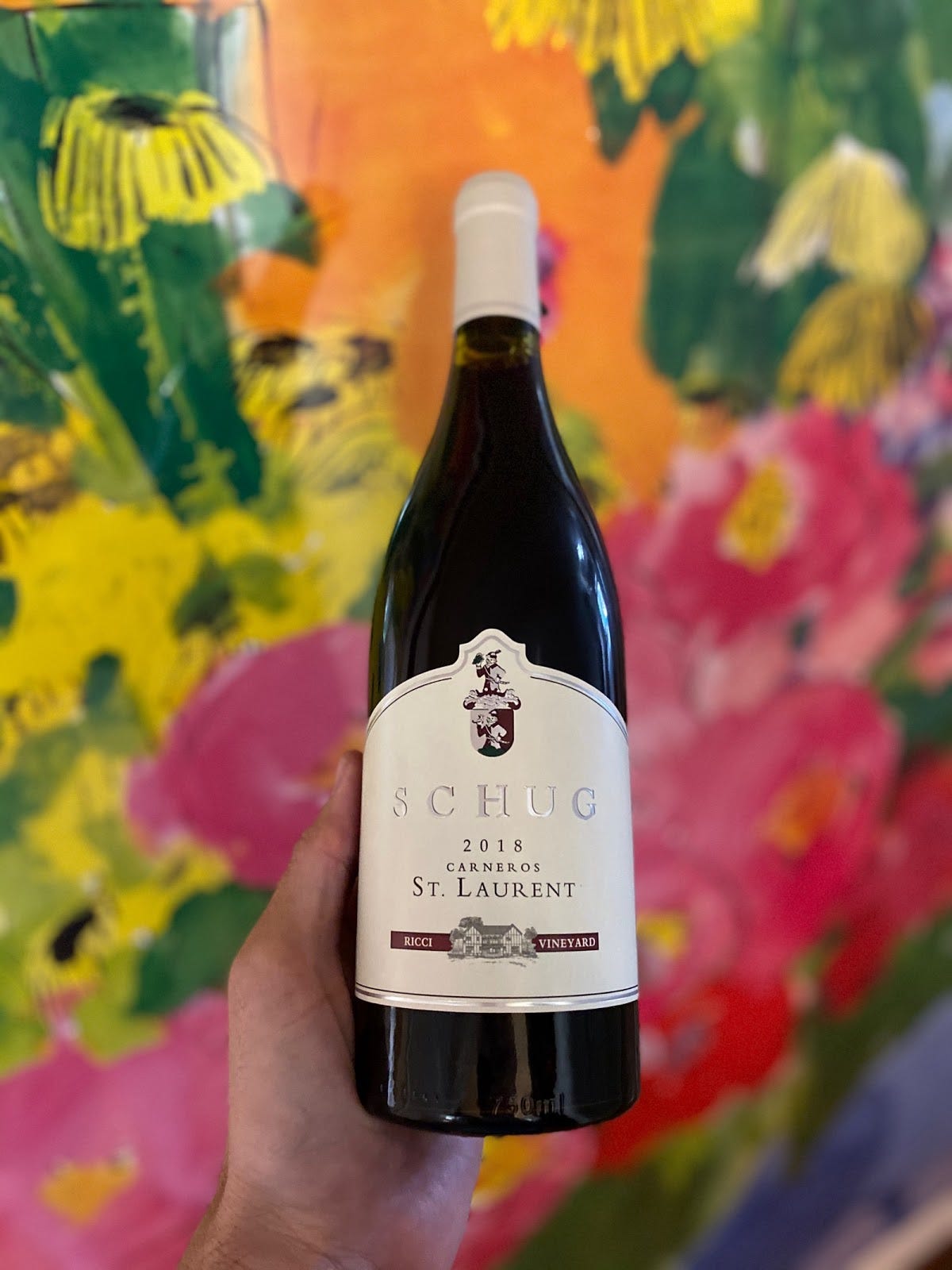
There’s a new grape in town.
Here in Northern California, we’re known for growing cabernet sauvignon, chardonnay, merlot, pinot noir, and even syrah and zinfandel. But have you heard of St. Laurent? If you haven’t — and you’re into wine — chances are you will soon. This Austrian red wine is rarely seen in the U.S. outside of a few hipster wine bars and shops, but it’s cropping up from smaller wineries and trendy stores, gaining attention for its rarity in California, its drinkability, and the quality of flavor for the price point.
I first sipped a California St. Laurent wine back in February, before the pandemic hit, at the Garagiste Wine Festival in Sonoma, which showcases small, independent wineries. As I scanned the event’s handbook listing what was being poured, several unique varieties stood out, but it was the St. Laurent that caught my eye since I’ve never heard of it being grown in the U.S.
Sign up for The Bold Italic newsletter to get the best of the Bay Area in your inbox every week.
I headed over to March Wines, run by Maura Johnson and her husband Charley. Johnson’s day job, she told me, was helping a famous Napa winery make their cult cabernet sauvignons. On the side, though, they were busy with their own label. March Wines creates something different than a cabernet sauvignon — quite the opposite: delicate, aromatic wines from unusual grape varietals including St. Laurent. As a new brand, this unique offering helps differentiate March Wines from the sea of swill available to consumers, and attracts younger buyers who can’t afford, or aren’t interested in, pricier mainstays.
“For my peers that are doing their own labels, I see them mostly doing obscure things, getting lower priced fruit from other areas,” Johnson said. As a wine lover herself, she added “I can’t drink $500 cabs every day.”
I noticed that, at the event, St. Laurent was also offered by another winery, Ricci Vineyards, which I learned had the only commercial plot of the grape in California, just 10 acres, planted on their Carneros farm, in the heart of pinot noir and chardonnay country.

St. Laurent often tastes like a mix between pinot noir and cabernet franc. Its rarity attracts wine geeks like me, although you don’t have to be an aficionado to enjoy it. St. Laurent also fits into a broader trend among the wine cognoscenti — the proliferation of funky, light, “quaffable” wines. The French refer to these wines as glou glou, which roughly means wines that are chuggable. These are wines to sip and enjoy without the need to study them like a collector worshipping every drop of an expensive bottle. These food-friendly, more balanced bottles have been attracting millennial drinkers as the industry shifts away from the big burly wines that boomers started fetishizing in the 1990s.
“Younger consumers don’t necessarily want to associate with their parents’ wine; they want to identify with their own brands and styles,” said Tyler Kohfeld, director of brand strategy for Ricci Vineyards. “Part of this differentiating is to gravitate to wine that not a lot of people have ever heard of.”
Because of the positive reception the wine has received, Ricci is considering planting other unique varieties popular in Austria such as blaufränkisch and zweigelt.

Mysterious heritage
St. Laurent gets its name from the fact that its skin begins to change color in early August, around Saint Lawrence Day. While it’s related to Pinot Noir, its other parent remains anonymous. Plantings of St. Laurent in Austria have “increased noticeably” during the past two decades and is now one of the country’s top grapes, making up 5% of the total red wine-growing area in that country, according to the Austrian Wine Marketing Group.
The wines it typically makes are described as “dark, sturdy, fruity, and piquant red wines with Morello cherry notes,” the organization says.
To chat about this trendy newcomer to the U.S., I reached out to Andreas Wickhoff, who received the prestigious “Master of Wine” status in 2012 — only the third Austrian in nearly 60 years to do so. Wickhoff is the general manager for winery Weingut Bründlmayer, where they bottle St. Laurent as a single varietal as well as include it in a blend for their brut rosé. I wanted to know what his fellow countrymen think about the grape.
“Consumers would recognize it as a varietal but as it is now widely planted, it is more like a petite syrah in Napa than a cab,” he wrote, meaning that while the grape has name recognition in Austria after years of expansion, the wine isn’t the star of the show like the top-planted varietal zweigelt. Still, he noted St. Laurent is known for its potential: “If treated well, this variety will bring out refined, complex, floral, and elegant wines.”
Globetrotting grape
By the early 2000s, Dale Ricci, the owner of Ricci Vineyards in Carneros, California, had 200 acres of land producing a few varieties — mostly the regional mainstays of pinot noir and chardonnay, but also syrah and merlot. However, interest in merlot had been declining across the industry, so Ricci ripped those vines out, and started looking for something unique that would flourish in Carneros’ cool climate. A contact of his, a German person who fondly recalled drinking St. Laurent back home, suggested the grape. Ricci was intrigued by this grape that was similar to Pinot Noir, but not available elsewhere in the U.S.
Fortuitously, Ricci’s contact happened to find a German grape grower, supposedly the last in the country with St. Laurent, who was ripping up his vineyard in order to convert it to other grapes. Before that could happen, Ricci’s contact secured some of these vines and brought them back to California. Acquiring the vines was one challenge — selling them was another.
Taking a chance
Interest in Ricci’s St. Laurent was lacking at first since few people knew what it was. That changed once Matthew Rorick took an interest around eight years ago. Rorick, winemaker and owner of Forlorn Hope Wines, is a known champion of unusual grapes, or “Rare Creatures,” as the winery refers to their offerings.
“We love the longshots. We love the outsiders, the lost causes, the people/projects/ideas abandoned as not having a chance in the world,” he writes on Forlorn Hope’s website.
Once other winemakers had tasted what Rorick could do with Ricci’s St. Laurent, more requests came in.
“From there, things have catapulted forward,” said Kohfeld, who is the director of brand strategy for the vineyard (and also Ricci’s stepson). “Currently the demand for the grape far exceeds supply and we have winemakers from very small, boutique brands making wine with it, as well as big players.”

‘Medieval Trading Post’
California winemakers have taken different approaches to making St. Laurent — some emphasizing a light touch, others showing more intervention. At least six wineries are bottling the grape, including a sparkling wine from Cruse Wine Company; both a rosé and red by March Wines; a steel- and concrete-aged version from Scribe; and a barrique-aged wine that producer Forlorn Hope romantically describes as evoking “swirling sights and sounds of a Medieval trading post on the frontier between old Europe and the Orient: strange beasts, exotic incense, wrought metal, redolent spices.”
Schug Carneros Estate Winery, a pinot noir and chardonnay powerhouse, also bottles a St. Laurent from Ricci Vineyards. Winemaker Johannes Scheid said Schug has been working with Ricci for two decades, buying a variety of grapes from him including pinot noir and syrah. When Ricci mentioned his interest in growing something offbeat like St. Laurent, Scheid was happy to tell him, “if you plant it, we’ll make some.”
Schug made their first Ricci Vineyards St. Laurent in 2016, and ages the wine in neutral oak to let the grape’s characteristics shine.
“The goal of the wine is to be fruit-forward, light, food-friendly,” Scheid said. “We don’t want to have the oak being overpowering.”

Ricci also bottles his own St. Laurent. The first thing I noticed when tasting the wine was a savory note that reminded me of cola — a similar flavor I sometimes taste in Russian River pinot noirs. However, it also had accents of raspberries and dried flowers. Overall, I found it to be a light, refreshing wine perfect for enjoying on a warm summer day.
Johnson, the winemaker at March Wines, also aims for a lighter version.
“Our style is ‘spring fresh.’ It has acidity to it, and it’s really fruity,” Johnson said. “It’s really similar to riesling — it’s food-friendly and super aromatic.”
That term “freshness” kept recurring in my tasting notes of all the St. Laurents I tried for this article. The descriptor usually refers to wines with great acidity that make your mouth salivate for more, and these bottles certainly did. While I enjoy the rich, tannic Napa cabernet sauvignons that made California famous, they don’t often pair well with foods other than steak. Plus the best examples are often priced well beyond what you’d want to pop and pour on any random night.
St. Laurent is an obscure choice. But with a growing number of well-regarded wineries experimenting with the grape, drinkers who have been seeking out these lighter, fresher glou glou wines will find a lot to like.







